What Is A SART?
As a crucial piece of search and rescue equipment, you have probably seen SARTs for sale in many nautical stores. Maybe you even have one on your own boat but are not sure what to do with it, or how it works.
A SART, or “Search and Rescue Transponder”, is an electronic device that transmits a distress signal to vessels in your immediate vicinity. Radar SARTs highlight your position on 9GHz radar screens, and AIS SARTs highlight your location on AIS receivers.
SARTs are a recognised distress signal within the International Regulations for Preventing Collisions at Sea:
“The following signals, used or exhibited either together or separately, indicate distress and need of assistance:
…approved signals transmitted by radio communication systems, including survival craft radar transponders.”
International Regulations for Preventing Collisions at Sea
Activating a SART has the same impact as using an EPIRB, or setting off flares. It means that you are in distress and need rescuing.
The only difference is that it is designed to be detected by other vessels that are relatively close to you. In comparison, EPIRBs are designed to be detected by satellites.
Radar SARTs paint a series of 12 echoes onto 9GHz radar screens. The idea is that the pattern is distinctive enough to be seen so that the vessel can turn towards the echo and rescue you.
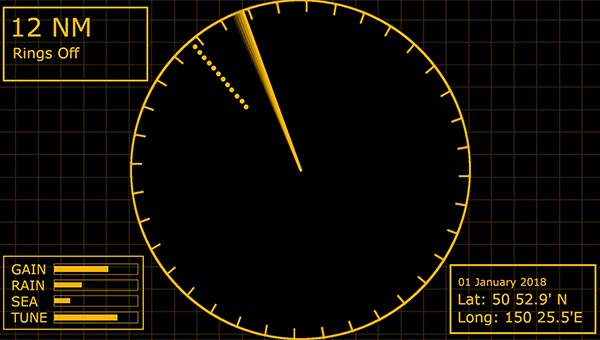
AIS SARTs do the same thing but on an AIS screen instead. They have been developed as a way of indicating distress through the AIS system. When vessels have AIS integrated into an electronic chart, a symbol will appear on the chart.
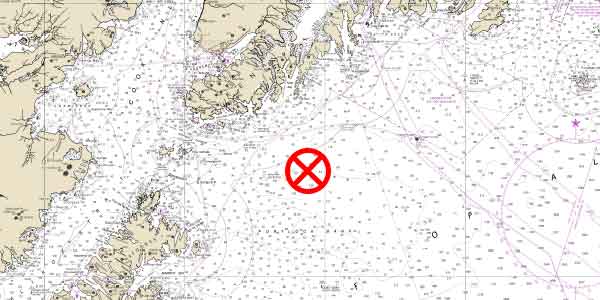
Vessels that do not integrate AIS with their charts will receive an alert on the AIS unit itself.
Regardless of whether you have an AIS SART or a Radar SART, the effect is the same. They are both transponders which send an electronic distress signal to vessels in your vicinity that are equipped with the corresponding equipment.
How do SARTs work?
Radar SARTs and AIS SARTs work slightly differently. If you would rather watch a video, I have made an animation of how a radar SART works. Otherwise, we’ll continue with the article below.
How does an AIS SART work?
AIS SARTs are the easiest to understand because they work in the same way as a regular AIS transmitter.
They use GPS to calculate their own position. Then they broadcast their identity along with that position on AIS frequencies. The signal is then received by other vessels with operational AIS, in the same way that they receive signals from other vessels.
The difference is that an AIS SART appears as a distinctive symbol so that you can tell it apart from other vessels.

The vessel receiving the SART signal can then plot a course towards the transponder in the same way they would when plotting a course towards any navigational marker.
How do radar SARTs work?
Radar SARTs are different from AIS SARTs because they are designed to be picked up by radar. They do not need to calculate their position or transmit their identity.
When activated, radar SARTs immediately enter a “listening mode”. This is a low power mode that the SART uses while waiting for a ship with operational radar to come within range.
When the SART detects pulses from the radar of a passing vessel, it switches itself into “transmission mode”.
In transmission mode, the SART waits until it is hit by the pulse from the radar it has detected. The moment the pulse hits the SART, it immediately transmits an identical pulse. This identical pulse travels straight back to the transmitting ship and appears as an echo on the radar screen.
It is the same echo that would appear had the original pulse bounced back from another vessel or object.
To make the SART distinctive, rather than transmit a single pulse back, it sends back a series of 12 pulses. The time difference between the pulses creates the illusion of other objects further away also returning an echo.
The result is that a series of 12 dots, spaced about 0.64M apart will appear on the radar screen.
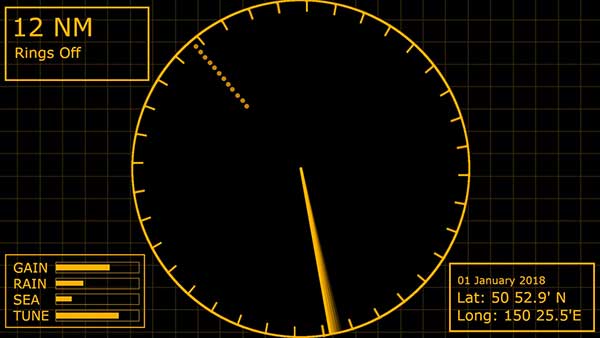
The closest echo is the true position of the SART. The receiving vessel can take a range and bearing using their radar and plot the position of the SART on a chart.
They can then set a course towards the SART, using their radar the whole time so that they can locate the vessel in distress.
What frequency do radar SARTs work on?
Radar SARTs operate on 9GHz. This is the frequency of a 3cm wavelength, X-Band marine radar.
Marine radars are split into two types, S-Band and X-Band.
| X-Band | S-Band | |
| Frequency | 9 GHz | 3 GHz |
| Wavelength | 3 cm | 10 cm |
The shorter wavelength and higher frequency give X-Band radars a better target resolution, allowing them to show things in more detail than S-Band radars.
The downside to this is that they are more susceptible to clutter from echos returning from the sea or droplets of rain in the atmosphere.
X-Band radars are the most common on commercial vessels. In accordance with SOLAS, Chapter 5, Regulation 19, they are required on all ships over 300GRT.
Additionally, 9GHz X-Band radars are the most common sort of radar carried on small pleasure vessels.
All of this leads to the logical conclusion that operating a SART on the 9GHz, X-Band range is the best solution as it stands the greatest chance of detection.
Is a vessel is running an S-Band radar, the SART will be invisible to them. This is because the transmission from the SART itself is at 9GHz, so it can only be detected by a radar set that is scanning its own pulses on that frequency.
What is the range of a radar SART?
A radar SART is typically detected at a range between 12M – 15M.
This range is derived from the range settings on a typical radar set, and the fact that the SART echos are spread across a range of approximately 9M.
Traditionally, radars can be set on specific different ranges: 3M; 6M; 12M; 24M; 48M.
Considering the series of 12 echos is spread across roughly 9 nautical miles, we can eliminate the 3M range. We can also see that while the 6M range can be used, you can expect some of the returns from the SART to be beyond the range of the screen.
With ranges of 12M and above, you can expect to see the entire series of pulses returned from the SART on your screen. It then becomes a matter of determining the maximum range that the SART can be detected.
Pro Tip: Only the first return from the SART needs to be within its maximum range. The other 11 returns are produced from the location of the first echo with a time delay, creating the illusion of added distance.
The range of a radar is determined mainly by the height of its scanner. In reality, it is also determined by the power of the radar set, but you will often find that you hit the geographical limit before you hit the power limit.
With the SART, it is safe to assume that if the scanner from the vessel can reach you, then your SART will be able to return an echo to them too.
Therefore, with a large ship, you may detect a SART up to 30M away on the 48M setting. On a smaller vessel, you can expect a SART to be detected around 15M away, showing up at the limits of the 24M range setting.
Pro Tip: The higher you mount your SART, the greater the range you can expect.
What is the range of an AIS SART?
With AIS SARTs, you are limited by the range of an AIS transmission. Typically, you might expect an operational range of 10M – 15M from an AIS SART.
AIS works on VHF frequencies. This limits its maximum range to be roughly line-of-sight.
A vessel with an antenna 50m above the waterline is likely to receive your transmission at a greater distance than a vessel whose antenna is only 5m above the waterline.
Just like the radar SART, you are likely to hit the geographical range of transmission before you are limited by the power of your SART.
Pro Tip: The higher you mount your SART, the further you can expect the transmission to travel.
What do SARTs look like on a radar?
On a radar, SARTs change their appearance as you get closer to them.
Initially, a SART will be a series on 12 dots, spaced about 0.6M apart. The echo closest to the centre of the screen is the true location of the SART, and the echos extending away from it are the additional, generated echos.

As you get closer to the SART, the dots start to get wider. They start to turn into a series of arcs, with the closest arc indicating the true position of the SART.
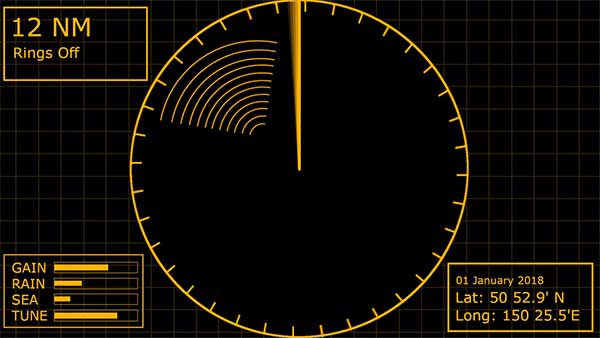
The reason that radar SARTs start to appear as arcs is because of the detection properties of the radar scanner.
Initially, it only detects the SART when it is pointing directly at the SART, giving a very narrow width to each of the echos.
As the SART gets closer to the scanner, it starts to be detected across a broader width, turning into arcs.
Specifically, it is being detected by the side lobes of the radar scanner. It is beyond the scope of this article, but you can read more about radar side lobes on Wikipedia: Side Lobes Wikipedia Article.
The closer the SART comes to the radar scanner, the wider the arcs become. Eventually, they will fill in completely and become a series of concentric circles.

The side lobes of the radar are now detecting the SART across its entire swept width.
Where should you mount a SART?
When it comes to mounting a SART, we have two different scenarios to consider.
Firstly, and most importantly, where it should be mounted in a distress situation. In other words, where it should be mounted when you are in a liferaft or lifeboat.
Secondly, where it should be mounted during normal day-to-day life, in its storage location.
Where should you mount a SART during a rescue?
In an emergency, a SART should be mounted as high as possible, above everything else on your survival craft.
In the sections above, we discussed how the effective range of a SART is influenced by its height. The higher it is, the further away you can expect to be detected.
The same principle applies to both radar SARTS and AIS SARTS.
Most SARTs come with a mounting pole which let you increase its height when you are mounting it.
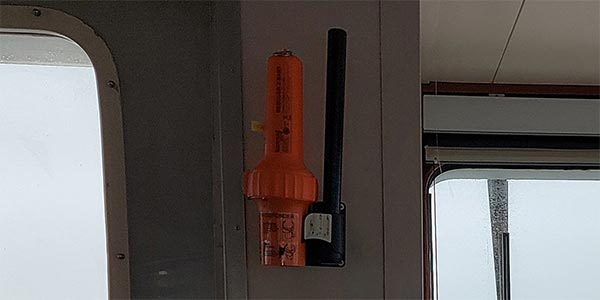
It’s just a case of attaching the pole to your lifeboat so that the body of the SART extends above everything else.
A critically important point when mounting a SART is that you need to remove any radar reflector that you are using.
Radar reflectors are designed to passively return a radar signal to a transmitter. Using a radar reflector at the same time as a SART will block the path of transmission of the SART in one direction.
Pro Tip: A SART must never be used at the same time as a radar reflector.
Where should you store your SART?
SARTs should be stored in the most accessible location so that you can grab them if you need to take to your survival craft in an emergency.
On small boats, the grab bag provides a good storage location for your SART. Theoretically, if you can only grab a single item, you want it to be the bag that contains all of your emergency equipment.
Other suitable locations on smaller boats include:
- Next to the helm, on the assumption that the helm is the one location on board, that is continuously occupied.
- At the entrance to the cabin, so that you can grab it on your way out of the cabin in an emergency.
- Next to, or inside, your survival craft.
On a commercial vessel, the storage location of SARTs is defined in international regulations.
SOLAS states that ships carrying two SARTs must have one on each side, in such a location that it can be easily placed in a survival craft in an emergency.
This means that ships usually carry one SART next to each bridge wing door so that it can be grabbed as the crew go to the survival craft. It could also mean that SARTs are carried next to the survival craft itself.
Ships that have a freefall lifeboat and two SARTs must keep one SART inside the lifeboat, and the other one on the navigation bridge.
Read more about freefall lifeboats in this article: What Types Of Lifeboats Are Used On Ships?
How do you test a SART?
As part of a vessel’s GMDSS equipment, regular testing of SARTs is essential.
Every month, they will be checked by the operator. On an annual basis, they will be serviced as part of the renewal of a ship’s radio certificate.
Each month, you just need to verify that the SART is in good condition, the battery is in date, and it is stored correctly. Most companies like to test the actual operation of the SART, although this is not strictly necessary as it is best done during the annual survey to avoid draining the battery.
Should you decide to test the operation of the SART, you just switch it on to “test” mode.
A radar SART will activate and be detectable by X-Band radars for the duration of the test. Think about it from the perspective of other vessels, it is a bit like testing your flares by firing one.
It is vital to make sure vessels in your vicinity cannot mistake your SART test for a real distress signal.
Undertaking a SART test in port is a good option because vessels at sea will likely not see it as the additional echoes will appear in the clutter from the land. From your vessel, you are close enough to the SART for it to appear as concentric rings on your screen.
With an AIS SART, things are a little simpler. Switching an AIS SART into “test” mode will encode the AIS transmission with a “test” identifier so that other vessel will immediately see that it is a test.
As I stated already, switching on a SART is not always necessary on a monthly test. The most important things to check are the expiry dates of the batteries and the physical condition of the SART itself.
How long should a SART battery last?
SART battery requirements state that it should last at least 96 hours in standby mode and 8 hours in interrogation mode.
When you first switch your radar SART on, it will enter standby mode. It is actively listening for an X-Band radar signal.
This is a lower power mode because it is not sending the 9GHz signal for other people to receive.
The battery must give it at least 96 hours operation time in standby mode.
Once it detects an active X-Band radar, the radar SART will switch to interrogation (transmission) mode.
In transmission mode, the radar SART will return a series of 12 pulses each time it is struck by an X-Band radar pulse, using significantly more power than it does in standby.
The battery must give at least 8 hours of operation time in interrogation mode.
Of course, it is the same battery that provides power in both of these modes. If the SART switches into interrogation mode before 96 hours, you can expect more than 8 hours transmission time.
Similarly, if the SART has not detected another radar within 96 hours of standby, it won’t switch off. It will just mean that there will be less than 8 hours of transmission time once it is detected.
AIS SARTs are a little different because they transmit immediately. There is no “standby” mode on an AIS SART. As such, they need to operate at their operational power for at least 96 hours.
Do I need to carry a SART?
Most small boats do not need to carry a SART.
Occasionally, local regulations may require that a SART is carried, but that is not very common.
Instead, you should consider a SART as an additional piece of safety equipment that it would be helpful to carry.
For me, instead of carrying a SART, I would just carry an AIS enabled EPIRB. The AIS on the EPIRB functions in the same way as an AIS SART.
SOLAS considers AIS SARTs as equivalent to radar SARTs, so if I can accomplish the same functions within my EPIRB then I’d rather carry that.
On commercial vessels, however, SART carriage is defined in law.
As a rule of thumb, all passenger vessels, and all cargo ships over 300 GRT are required to carry a SART.
I have written a complete article about how many SARTs are needed on a ship, which you can read here: How Many SARTs Are There On A Ship?
Which ships need to carry SARTs?
In accordance with SOLAS regulations, the following vessels need to carry SARTs.
| Vessel | Number of SARTs |
| RoPax vessels | 1 for every 4 liferafts (min 2) |
| Passenger vessels | 2 |
| Cargo ships >500 GRT | 2 |
| Cargo ships between 300 GRT & 500 GRT | 1 |
Ro-ro passenger vessels
RoPax ships are classed as passenger ships, so they need a minimum of one SART on either side.
They have an additional requirement of carrying at least 1 SART for every 4 liferafts though.
SARTs within liferafts are contained within the liferaft canister itself, so are serviced at annual intervals when the liferaft is serviced.
Passenger vessels
Passenger vessels need to carry a minimum of one SART on each side of the ship.
Cargo ships >500 GRT
Large cargo ships need to carry a minimum of one SART on each side of the ship.
If the ship has a freefall lifeboat, one SART must be kept inside the freefall lifeboat, and the other one on the navigational bridge.
Cargo ships between 300 GRT and 500 GRT
Small cargo ships need to carry at least one SART.
